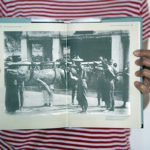Puits
2008 - Sculpture (Sculpture)
Guillaume Leblon
Puits (“Wells”) is a circle made ??of raw earth elements, at the scale of Leblon’s hands. In this work, Guillaume Leblon reclaims the tactility of clay, as a classical material of sculpture, which we can also see in his other works like Raum (2006), National Monument (2006), and Notes (2007). Puits (“Wells”) suggests a universe of the past, like the 700 wells of Mohenjo-daro, the thriving Indus city from the second millennium BC (Pakistan, cf. Link). In the case of Guillaume Leblon, this form is a reminiscencence, as developed by Aby Warburg, whose forms survive and reappear through the ages and places. This work points toward the idea of wells, mimicking their shapes, while questioning their use. This well is not functional and resists to water. Its hole is replaced by a space enclosed with brick. Maybe the well is a metaphor of the opening artist’s studio to the world? The artist introduces a sense of fragility between unstable equilibrium and the threat of collapse.
Guillaume Leblon is a sculptor, who questions the vocabulary of forms – he uses material encompassing copper alloy of tin and zinc, flows like water, lightning, smoke, and space to express notions of landscape and weightlessness. During an exhibition at Sonsbeek in the Netherlands, Leblon proposed the work “Temps libre” (Free Time) (2001), a jump from three floors of the tallest building in Arnhem. His works function as indices, in form, references or emotions, creating a very special atmosphere which reflects his interest in modernism that he defines as “a total art that includes a real time.” In Leblon’s work, perception of space by the viewer is often precarious and ambiguous due to subtle alterations. Guillaume Leblon was born in 1971 in Lille, France. He lives and works in Paris.
Colors:
Related works sharing similar palette
» see more

© » KADIST
Toby Ziegler
2005The Fifth Quarter might have taken its mysterious inspiration from the eponymous Stephen King story collated into the Nightmares & Dreamscapes collection...

© » KADIST
Tony Cokes
2022Tony Cokes’s long-form, multi-channel work Some Munich Moments 1937–1972 forms a layered montage of historical and contemporary source material exploring different periods of Munich’s history...
Related artist(s) to: Guillaume Leblon » Ryan Gander, » Dove Allouche, » Laurent Montaron, » Aurélien Froment, » Dora GarcíA, » Gabriel Orozco, » Gerhard Richter, » Gustav Metzger, » Joachim Koester, » Julien Discrit
» see more

© » KADIST
Joachim Koester
2007Tarantism is the name of disease which appeared in southern Italy, resulting from the bite of a spider called Tarantula...

© » KADIST
Dora Garcia
2012KLAU MICH is a TV and performance project by Dora García with Ellen Blumenstein, Samir Kandil, Jan Mech, TheaterChaosium, and Offener Kanal Kassel, during the 100 days of dOCUMENTA (13)....

© » KADIST
Dora Garcia
2008Dora Garcia’s work is a result of institutional critique and more generally that of language, following the conceptual artists of the 1960s like Weiner and Kosuth and Fraser from the 1980s and 1990s...
Related works found in the same semantic group
» see more

© » KADIST
Oscar Munoz
2009In Ante la imagen (Before the Image, 2009) Muñoz continues to explore the power of a photograph to live up to the memory of a specific person...

© » KADIST
Yoan Capote
2007Open Mind is a model created by Capote for a traversable public maze that, when seen from above, resembles the human brain...





